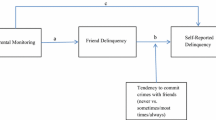Abstract
The issue of juvenile delinquency continues to concern both policy makers and parents. Engaging in negative behaviors or activities that are not socially acceptable can have serious implications for adolescents' physical, emotional, and social development. Therefore, it is important that human service practitioners working with adolescents understand those factors that influence their delinquent behavior in order to develop effective interventions. This paper reports the findings of a study of self-reported delinquent activity among a sample of 779 adolescents who attended middle schools in a large urban city in the southwest United States. The study examines the relationships between delinquent behavior, social support, and a variety of other psychosocial factors. The implications of those relationships for human service practice and research are discussed.
Similar content being viewed by others
References
Barrera, M. (1986). Distinctions between social support concepts, measures, and models. Journal of Community Psychology, 14, 413-446.
Barth, R. (1983). Social support networks in services for adolescents and their families. In J. K. Whittaker & J. Garbarino (eds.) Social support networks: Informal helping in the human services, pp. 299-330. New York: Aldine.
Blau, B. I. (1996). Oppositional Defiant Disorder. In G. M. Blau and T. P. Gullotta (eds.) Adolescent dysfunctional behavior: Causes, interventions, and prevention, pp. 61-82. Thousand Oaks, CA: Sage.
Borduin, C. M., Henggeler, S. E., & Manley, C. M. (1995). Conduct and oppositional disorders. In Vincent Van Hasselt & Michel Hersen (eds.), Handbook of adolescent psychopathology: A guide to diagnosis and treatment, pp. 349-383. New York: Lexington.
Brooks, A. J., Stuewig, J., & LeCroy, C. W. (1998). A family based model of Hispanic adolescent substance use. Journal of Drug Education, 28,(1) 65-86.
Cohen, S., & Syme, S. L. (Eds.). (1985). Social support and health. New York: Academic Press.
Cohen, S., & Wills, T. A. (1985). Stress, social support, and the buffering hypothesis. Psychological Bulletin, 98, 310-357.
Dacey, J., & Kenny, M. (1994). Adolescent development. Madison, WI: W. C. B. Brown & Benchmark.
Dryfoos, J. (1990). Adolescents at risk. New York: Oxford Press.
Dryfoos, J. (1998). Safe passage: Making it through adolescence in a risky society. New York: Oxford.
Hawkins, J. D., & Fraser, M. W. (1983). Social support networks in delinquency prevention and treatment. In J. K. Whittaker & J. Garbarino (eds.) Social support networks: Informal helping in the human services, pp. 333-356. New York: Aldine.
Hawkins, J. D., & Weiss, J. G. (1985). The social development model: An integrated approach to delinquency prevention. Journal of Primary Prevention, 6(2), 73-97.
Howell, J. C., Krisberg, B., & Jones, M. (1995). Trends in juvenile crime and youth violence. In J. C. Howell, B. Krisberg, J. D. Hawkins, & J. J. Wilson (eds.) A sourcebook: Serious, violent, & chronic juvenile offenders, pp. 1-35. Thousand Oaks, CA: Sage.
Institute of Medicine (1994). Reducing risks for mental disorders: Frontiers for preventive intervention research. Washington, DC: National Academy Press.
Kazdin. A. E. (1995). Conduct disorders in childhood and adolescence, 2nd ed. Thousand Oaks, CA: Sage.
Lock, J. (1996). Disruptive behavioral disorders. In H. Steiner (ed.) Treating adolescents, pp. 43-76. San Francisco, CA: Jossey-Bass.
Loeber, R. (1990). Development and risk factors of juvenile antisocial behavior and delinquency. Clinical Psychology Review, 10, 1-41.
MacNeil, G., Kaufman, A. V., Dressler, W. W., & LeCroy, C. W. (1999). Psychosocial moderators of substance use among middle school-aged adolescents. Journal of Drug Education, 29(1), 25-39.
McWhirter, J. J., McWhirter, B. T., McWhirter, A. M., & McWhirter, E. H. (1993). At-risk youth: A comprehensive response. Pacific Grove, CA: Brooks/Cole.
Resnick, G., & Burt, M. R. (1996). Youth at risk: Definitions and implications for service delivery. American Journal of Orthopsychiatry, 66(2), 172-188.
Robbins, L. N. (1991). Conduct disorder. Journal of Child Psychology and Psychiatry and Allied Disciplines, 32, 193-212.
Rutter, M. (1985). Resilience in the face of adversity: Protective factors and resilience to psychiatric disorder. British Journal of Psychiatry, 147, 598-611.
Santrock, J. W. (1994). Child development. Madison, WI: W. C. B. Brown & Benchmark.
Snyder, H. (1994). Are juveniles driving the violent crime trends? Fact Sheet #16. Washington, DC: Office of Juvenile Justice and Delinquency Prevention.
Thornberry, T. P., Huizinga, D., & Loeber, R. (1995). The prevention of serious delinquency and violence. In J. C. Howell, B. Krisberg, J. D. Hawkins, & J. J. Wilson (eds.) A sourcebook: Serious, violent, & chronic juvenile offenders, pp. 213-237. Thousand Oaks, CA: Sage.
Vaux, A. (1982). Measures of three levels of social support: Resources, behaviors, and feelings. Carbondale, IL: Southern Illinois University, Dept. of Psychology.
Vaux, A. (1988). Social support: Theory, research, and intervention. New York: Praeger.
Weibush, R. G., Baird, C., Krisberg, B., & Onek, D. (1995). Risk assessment and classification for serious, violent, and chronic juvenile offenders. In J. C. Howell, B. Krisberg, J. D. Hawkins, & J. J. Wilson (eds.) A sourcebook: Serious, violent, & chronic juvenile offenders, pp. 171-212. Thousand Oaks, CA: Sage.
Williams, J. H., Ayers, C. D., & Arthur, M. W. (1998). Risk and protective factors in the development of delinquency and conduct disorder. In M. W. Fraser (ed.) Risk and Resilience in Childhood: An Ecological Perspective, pp. 140-170. Washington, D.C.: NASW Press.
Rights and permissions
About this article
Cite this article
MacNeil, G., Stewart, J.C. & Kaufman, A.V. Social Support as a Potential Moderator of Adolescent Delinquent Behaviors. Child and Adolescent Social Work Journal 17, 361–379 (2000). https://doi.org/10.1023/A:1007555014397
Issue Date:
DOI: https://doi.org/10.1023/A:1007555014397




